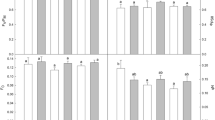Abstract
The overall success of a plant in coping with low temperature sensitivity of photosynthesis is dependent not only on the maximum extent of inhibition suffered for a given time of low temperature exposure but also on the persistence of the inhibition after normal growth temperatures are restored. Thus the capacity of recovery and the speed with which a plant can recover from the effects of chilling exposure are important parameters in determining how devastating the chilling event will be on season-long growth and yields. We have studied the recovery of CO2-saturated photosynthesis from the injury caused by exposing intact tomato plants (Lycopersicon esculentum Mill. cv. Floramerica) or detached tomato leaves to a temperature of 1°C in the dark for varying periods of time. We found that net photosynthesis was fully recovered within 12 h after returning the plants to 25°C in the dark, even after chilling exposures as long as 45 h. This was true for intact plants as well as for detached leaves that were supplied with water. When chilling took place in the light (4°C, 1000 μE · m-2 · s-1, PAR) inhibition of photosynthesis was more severe and appeared more quickly and the recovery was slower and incomplete. A 12 h chilling exposure in the light resulted in injury to net photosynthesis that was not fully recovered even after 50 h. Chilling damage to photosynthesis developing in the light was distinguished from chilling in the dark by the decreased photosynthetic quantum yield. Not only did high intensity illumination enhance chilling damage of photosynthesis but bright light subsequent to the chilling exposure also delayed the recovery of photosynthesis. At none of the three ambient CO2 concentrations investigated (300, 1500 and 5000 μ1.1-1) did the recovery of photosynthesis depend on stomatal conductance.
Similar content being viewed by others

References
Baker, NR, East, TM and Long, SP (1983) Chilling damage to photosynthesis in young Zea mays. II. Photochemical function of thylakoids in vivo. J Exp Bot 34:189–197
Garber, MP (1977) Effect of light and chilling temperatures on chilling-sensitive and chilling-resistant plants. Pretreatment of cucumber and spinach thylakoids in vivo and in vitro. Plant Physiol 59:981–985
Garber, MP (1979) Low temperature response of chloroplast thylakoids. In Lyons, JM et al., eds. Low temperature stress in crop plants. The role of the membrane, pp. 203–214. New York: Academic Press
Gaastra, P (1959) Photosynthesis of crop plants as influenced by light, carbon dioxide, temperature and stomatal diffusion resistance. Meded Landbouwhogesch Wageningen 59:1–68
Izhar, S and Wallace, DH (1967) Effect of night temperature on photosynthesis of Phaseolus vulgaris L. Crop Sci 7:546–547
Kaniuga, Z, Sochanowicz, B, Zabek, J and Krzystyniak, K (1978) Photosynthetic apparatus in chilling-sensitive plants. I. Reactivation of Hill reaction activity inhibited on the cold and dark storage of detached leaves and intact plants. Planta 140:121–128
Kee SC, Martin B and Ort DR (1984) Chilling inhibition of photosynthesis in tomato in the absence and in the presence of bright light. Photosyn Res. In Press
Kislyuk, IM and Vas'kovskii, MD (1972) Effect of cooling cucumber leaves on photosynthesis and photochemical reactions. Fiziol Rast 19:813–818
Long, SP, East, TM and Baker, NR (1983) Chilling damage to photosynthesis in young Zea mays. I. Effects of light and temperature variation on photosynthetic CO2 assimilation. J Exp Bot 34:177–188
Low, PS, Ort, DR, Cramer, WA, Whitmarsh, J and Martin, B (1984) Search for an endotherm in chloroplast lamellar membranes associated with chilling-inhibition of photosynthesis. Arch Biochem Biophys 231:366–344
Margulies, MM and Jagendorf, AT (1960) Effect of cold storage of bean leaves on photosynthetic reactions of isolated chloroplasts. Arch Biochem Biophys 90:176–183
Martin, B and Ort, DR (1982) Insensitivity of water-oxidation and photosystem II activity in tomato to chilling temperatures. Plant Physiol 70:689–694
Martin, B, Ort, DR and Boyer, JS (1981) Impairment of photosynthesis by chilling-temperatures in tomato. Plant Physiol 68:329–334
Ort, DR and Martin, B (1983) Chilling-induced inhibition of photosynthesis in tomato. In Marcelle, R et al., eds. Effect of stress on photosynthesis, pp. 227–235, The Hague, Boston, London: Martinus Nijhoff/Dr W Junk Publishers
Powles, SB, Berry, JA and Björkman, O (1983) Interaction between light and chilling temperature on the inhibition of photosynthesis in chilling-sensitive plants. Plant Cell Environ 6:117–123
Taylor, AO and Rowley, JA (1971) Plants under climatic stress. I. Low temperature, high light effects on photosynthesis. Plant Physiol 74:713–718
Author information
Authors and Affiliations
Rights and permissions
About this article
Cite this article
Martin, B., Ort, D.R. The recovery of photosynthesis in tomato subsequent to chilling exposure. Photosynth Res 6, 121–132 (1985). https://doi.org/10.1007/BF00032787
Received:
Accepted:
Issue Date:
DOI: https://doi.org/10.1007/BF00032787


